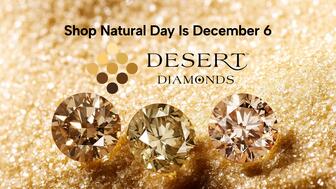Peter Smith: 7 Things to Know When Selling Luxury
Ahead of the holiday season, Smith delves into the often subconscious reasons people buy luxury products for themselves or their loved ones.

If you’ve been in the business for even 10 minutes, you’d be forgiven for marveling at the degree to which even sellers of fine jewelry disagree on what motivates customers to buy luxury products.
There are, of course, important occasions that people choose to celebrate with jewelry: engagements, anniversaries, holidays, etc.
But the decision to mark those occasions with jewelry, as opposed to trips or other alternatives, is exactly that—a choice, not an obligation, and people are happy to do it.
In fact, they’ve done so in record numbers in recent years.
In the 1940s, De Beers launched a terrifically successful campaign that, in the ensuing decades, primed couples to covet diamond rings as the ultimate symbol of love and to mark their occasions accordingly.
Using diamonds in engagement rings went from about 10 percent when De Beers began their messaging in the ‘40s to about 85 percent today.
A decade later, Tiffany & Co., which had been the first retailer in the United States to carry Patek Phillippe watches (1851), combined on a co-branding initiative with Rolex that featured the Tiffany name on the dials.
The partnership served both companies until it ended in the 1990s, purportedly a result of disagreements over inconsistencies in the stamping on the dials.
Of course, our definition of luxury doesn’t have to include the aforementioned iconic brands.
It’s clear we don’t buy jewelry out of necessity any more than we buy timepieces to tell time. There’s something more fundamental, almost mysterious, about our decisions to spend money on luxuries.
As we find ourselves heading quickly into the holiday season, so critical to so many in our business, what we do in the coming weeks will go a long way toward deciding what kind of year we ultimately will have.
While this year has seen a decline in same-store sales at the majors, independent jewelry stores, as of the end of September, continue to track ahead of a very robust 2023.
To that end, there is no greater factor in year-end performance than superb sales execution and, if I may be so bold, store owner mindset.
If you believe customers are best served by imagining they’re all motivated to find a deal, a discount, or something a little bit cheaper than usual, you will be 100 percent correct, and you will under-deliver to both the customers and your business.
On the other hand, if you recognize that 95 percent of our thinking (read: customers’ also) happens in our unconscious minds, and customers may in fact prefer you not prejudge them or their motivations for buying jewelry, great things can happen.
I usually write a column this time of year with a list of tips for salespeople.
This year, I thought it might be more interesting to share a few reminders of why the behavioral psychologists and academics believe customers buy luxury products.
It might be an interesting topic for a meeting to kick off the season and help you flush out any stinking thinking about under-reaching your customers.
1) Sense of Control/Agency
From the time we are toddlers we crave control and agency.
We see in all walks of life the negative impacts of taking agency away from people, very evident when managing personnel.
That agency is also true in consumer behavior.
Sometimes, the act of spending itself is a significant factor in buying luxury. It’s as if the customer is saying, “I can, therefore I will!”
2) The Creation of Their Own Brand Identity
When a customer buys luxury products, it is often happening (consciously or otherwise) as a construct of their own brand identity.
They are literally buying to make a statement about who they want to be, and wearing luxury brands and products can be a self-directed and/or outwardly directed expression of that aspiration.
It may also be a declaration about their place in the social hierarchy.
3) Psychologically Rewarding to Gift
Giving important gifts can be more rewarding to the giver than to the receiver. Again, behavioral psychologists have identified givers as enjoying a dopamine hit when they gift to others.
The joy of bestowing jewelry to a loved one, for formal or informal reasons, can be a more fulfilling experience than buying for oneself.
4) Often Tied to a Background of Hardship
The late Jack Welch, former CEO of General Electric, once had a life-threatening heart attack.
He was later asked by a reporter what went through his head as he was being whisked to the ER in an ambulance and he replied that if he survived, he would never buy a bottle of wine under $100 again.
Welch revealed that he had grown up in poverty “without two nickels to rub together” and he’d had enough cheap wine in his life.
A life of struggle, hardship even, can be a great incentive to buy luxury if you later find yourself in a position to do so.
There is ample evidence to support the fact that even people generally not regarded as being part of the luxury product buying demographic do so anyway, even sacrificing other needs in their lives to make it happen.
It’s as if buying luxury itself is an act of defiance.
5) Price Is a Proxy for Quality
When purchasing luxury goods, especially so with products the customer does not have a good grasp of, price serves as a proxy for quality.
The customer reasons that if they are paying a princely sum for an item of jewelry, the piece must be of exceptional quality.
The effect is even more profound when the item is a limited edition, one of a kind, or in short supply.
6) The Act of Spending Is Hedonistic
There’s a certain hedonistic quality to spending large sums of money on luxury products.
Some psychologists speculate that because “investing” is done privately, the act of “spending” is a public statement you make, as it allows you to announce your status.
In those situations, the joy comes from the act of spending.
7) Just Because
Finally, people buy luxury products because they want to.
They don’t always need internal or external rationalizations to make major purchases; it’s just something they choose to do for whatever reason, or for no reason at all.
When customers spend money on jewelry, diamonds, or watches, we don’t need to know what their motivation is. Just compliment them on their good taste and thank them for their business.
Happy retailing!
The Latest

The filmmaker’s personal F.P. Journe “FFC” prototype was the star of Phillips’ recent record-setting watch auction in New York.

The new location in the Design District pays homage to Miami’s Art Deco heritage and its connection to the ocean.

Inflations, tariffs, and politics—including the government shutdown—were among consumers’ top concerns last month.

How Jewelers of America’s 20 Under 40 are leading to ensure a brighter future for the jewelry industry.

“Longtime favorite” presenters, as well as first-time speakers, will lead talks and workshops at the annual event in Tucson next year.


Silas Smith of Meridian Metalworks won the challenge with his pendant that blends Australian and American landscapes.

The sale of the 31.68-carat, sunset-hued stone was part of Sotheby’s first series of events and auctions in Abu Dhabi.

Roseco’s 704-page catalog showcases new lab-grown diamonds, findings, tools & more—available in print or interactive digital editions.

The collection features characters and motifs from Ukrainian folklore, including an enchanted mirror and a magic egg.

MatrixGold 3.11, the newest version of the jewelry design program, offers more flexibility, precision, and creative control.

The pavilion will be part of the 2026 JA New York Spring show, scheduled for March 15 to 17.

Kadet, a 1994 National Jeweler Retailer Hall of Fame inductee, helped grow the family-owned retailer in the Chicago area and beyond.

Billed as the world’s smallest wearable, Lumia Health’s new smart earrings have a health tracker subtly embedded in the back.

Don’t let those with December birthdays feel blue. Help them celebrate their month with blue zircon, turquoise, and tanzanite.

The new pink sapphire version of the piece dances with its wearer in the brand’s “Icons After Dark” holiday campaign.

A choice that’s generated a lot of commentary, Pantone says “Cloud Dancer” marks a fresh start and encourages relaxation and creativity.

The manufacturer’s holiday campaign features a gift guide filled with trending designs and jewelry that can be personalized.

The man was charged with theft, accused of ingesting the necklace while in a jewelry store in Auckland, New Zealand.

The Florida independent expanded its store from 8,000 to 14,000 square feet, fulfilling the vision of its late co-founder, Jim Dunn.

Sponsored by De Beers Group

The classic 5600 series G-Shock has been scaled down to about a tenth of its size, becoming a fully functioning watch ring.

The association’s annual conference and gala will take place Feb. 4, 2026, during the Tucson gem shows.

The January show will include a workshop for jewelry retailers on implementing AI to strengthen their businesses.

Fellow musician Maxx Morando proposed to the star with a chunky, cushion-cut diamond ring designed by Jacquie Aiche.

The retailer, which sells billions in fine jewelry and watches, is suing the Trump administration and U.S. Customs and Border Patrol.

Black Friday is still the most popular shopping day over the five-day holiday weekend, as per the National Retail Federation’s survey.

The historic egg, crafted for Russia's ruling family prior to the revolution, was the star of Christie’s recent auction of works by Fabergé.






























